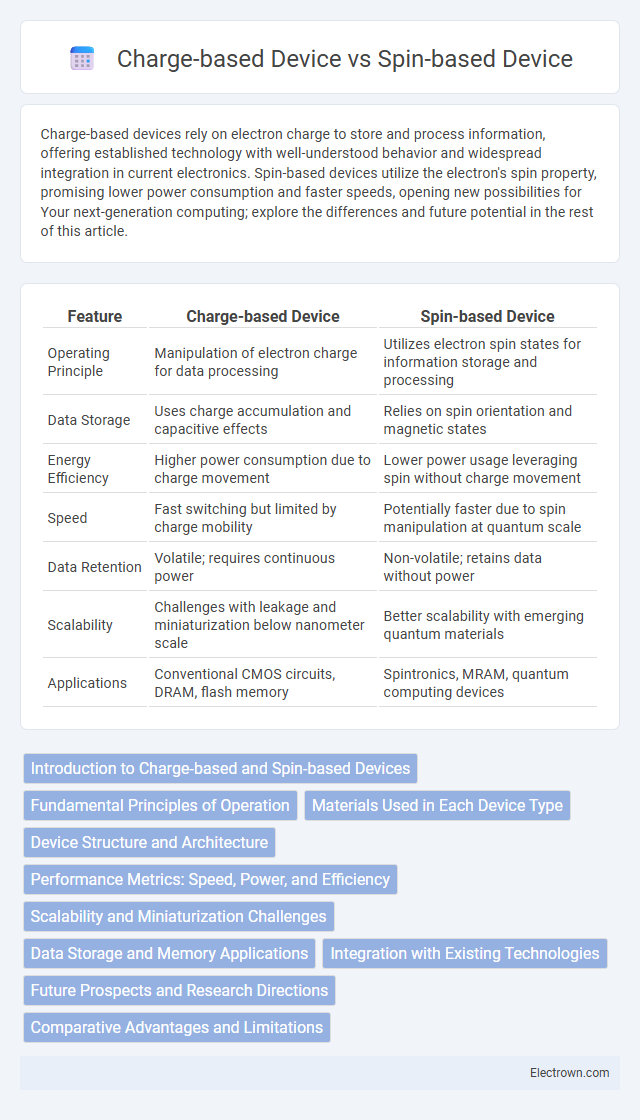Charge-based devices rely on electron charge to store and process information, offering established technology with well-understood behavior and widespread integration in current electronics. Spin-based devices utilize the electron's spin property, promising lower power consumption and faster speeds, opening new possibilities for Your next-generation computing; explore the differences and future potential in the rest of this article.
Table of Comparison
| Feature | Charge-based Device | Spin-based Device |
|---|---|---|
| Operating Principle | Manipulation of electron charge for data processing | Utilizes electron spin states for information storage and processing |
| Data Storage | Uses charge accumulation and capacitive effects | Relies on spin orientation and magnetic states |
| Energy Efficiency | Higher power consumption due to charge movement | Lower power usage leveraging spin without charge movement |
| Speed | Fast switching but limited by charge mobility | Potentially faster due to spin manipulation at quantum scale |
| Data Retention | Volatile; requires continuous power | Non-volatile; retains data without power |
| Scalability | Challenges with leakage and miniaturization below nanometer scale | Better scalability with emerging quantum materials |
| Applications | Conventional CMOS circuits, DRAM, flash memory | Spintronics, MRAM, quantum computing devices |
Introduction to Charge-based and Spin-based Devices
Charge-based devices operate by manipulating the flow of electric charge carriers, primarily electrons, to perform electronic functions, relying on charge accumulation and movement in semiconductors or conductors. Spin-based devices, also known as spintronics, utilize the intrinsic spin of electrons along with their charge, enabling data storage and processing through spin states, which can offer non-volatile memory and potentially lower power consumption. The fundamental difference lies in charge-based devices exploiting electron charge for logic and memory operations, whereas spin-based devices harness electron spin, paving the way for advanced functionalities like magnetic random-access memory (MRAM) and spin transistors.
Fundamental Principles of Operation
Charge-based devices operate by manipulating the flow of electric charge through semiconductor materials, relying on electron charge for switching and information processing. Spin-based devices utilize the intrinsic spin of electrons and spin currents to represent and control data, offering non-volatile memory and potentially lower energy consumption. Your understanding of these fundamental principles highlights the distinction between charge transport and spin manipulation in advanced electronic and spintronic applications.
Materials Used in Each Device Type
Charge-based devices primarily utilize silicon and other semiconductor materials such as gallium arsenide for efficient electron transport. Spin-based devices often incorporate materials with strong spin-orbit coupling like ferromagnetic metals (e.g., cobalt, nickel) and topological insulators to manipulate electron spin states. Your choice between these devices depends on material compatibility with performance requirements, especially considering spin coherence and charge mobility.
Device Structure and Architecture
Charge-based devices rely on electron charge to function, featuring traditional transistor architectures such as MOSFETs with layered semiconductor and oxide materials designed for efficient charge control and switching. Spin-based devices utilize electron spin states, incorporating materials like ferromagnets and heavy metals in multilayered structures to manipulate spin currents and enable non-volatile memory and logic operations. Your choice between the two significantly affects device architecture, where charge-based systems prioritize gate control and channel formation, while spin-based devices focus on spin injection, detection, and manipulation within complex heterostructures.
Performance Metrics: Speed, Power, and Efficiency
Spin-based devices excel in speed due to their ability to manipulate electron spin states with minimal latency, outperforming traditional charge-based devices in switching times often reaching picoseconds. Power consumption in spintronics is significantly lower because information is processed through spin rather than charge movement, reducing Joule heating and enabling energy-efficient operations. Efficiency gains are evident as spin-based devices sustain non-volatile states without continuous power, enhancing overall system performance in memory and logic applications compared to charge-based architectures.
Scalability and Miniaturization Challenges
Charge-based devices face significant scalability challenges due to increased power consumption and heat dissipation as transistor sizes approach physical limits, hindering further miniaturization. Spin-based devices offer potential advantages in scalability by utilizing electron spin rather than charge, enabling lower energy operation and non-volatile memory integration at nanoscale dimensions. You must consider materials engineering and quantum coherence maintenance to address miniaturization obstacles in spintronic device development effectively.
Data Storage and Memory Applications
Spin-based devices leverage electron spin states to store data, enabling non-volatile memory with faster access times and lower power consumption compared to traditional charge-based devices that rely on electron charge accumulation. Spintronic memory technologies such as MRAM (Magnetoresistive Random Access Memory) offer superior endurance and scalability, overcoming limitations of charge-based DRAM and flash memory in data storage density and retention. Emerging spin-based devices integrate better with nanoscale architectures, facilitating ultra-dense, energy-efficient memory applications critical for next-generation computing systems.
Integration with Existing Technologies
Charge-based devices leverage well-established CMOS technology, enabling seamless integration with current semiconductor manufacturing processes and infrastructure. Spin-based devices, while promising enhanced performance and lower power consumption, face challenges in compatibility with conventional silicon technology due to different material and operational principles. Research efforts aim to develop hybrid architectures that combine spintronic elements with traditional charge-based circuits to achieve practical integration in future electronic systems.
Future Prospects and Research Directions
Spin-based devices offer promising advancements in non-volatile memory and quantum computing due to their low power consumption and high-speed operation, driving significant research in spintronics materials and interface engineering. Charge-based devices continue to evolve with developments in nanoscale transistors and novel semiconductors, maintaining relevance in traditional computing architectures. Future research increasingly focuses on hybrid systems combining spin and charge phenomena to enhance device efficiency, scalability, and integration density for next-generation electronics.
Comparative Advantages and Limitations
Charge-based devices, relying on electron charge, excel in well-established technology, high-speed operation, and ease of integration with existing semiconductor processes but face limitations like power consumption and heat dissipation. Spin-based devices leverage electron spin for nonvolatile memory and lower energy consumption, offering higher data density and faster switching speeds while struggling with material uniformity, spin coherence, and scalability challenges. Both approaches present distinct trade-offs in performance, energy efficiency, and technological maturity impacting their application in future computing architectures.
Charge-based Device vs Spin-based Device Infographic

 electrown.com
electrown.com